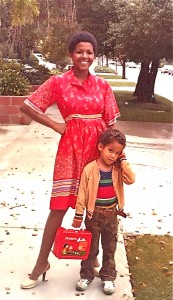
In writing my recent book, Split at the Root: A Memoir of Love and Lost Identity (Kindle) or Split at the Root: A Memoir of Love and Lost Identity, I tell the story of growing up within a culture and a race that was different to my own. Here’s an excerpt:
On our first vacation we visited friends in San Miguel de Allende, Mexico. We not only fell in love with the quaint village, we decided to move there. I’d take up painting, I reasoned, while Fred worked in the US and came to visit every month and a half or so. Patrick took the uprooting and settling and resettling in stride: it was a family affair. Together we packed our things, together we traveled, together we unpacked and rearranged everything in a new home, elsewhere. Patrick spoke English and German; now he needed to learn to say everything in Spanish, and he did. I enjoyed living among artists again, mainly because in San Miguel it was an international European group.
After a year and a half – Patrick was in second grade – he began to ask the sort of questions that would not have occurred to me as a child.
“Am I German, Mommy?”
“No, sweetheart,” I answered, “but you were born in Germany.”
“Are you German?”
“No, Patrick, I’m Guatemalan.”
“Am I Guatemalan, then?”
“No, you are American, like your dad.” That sufficed for the afternoon and lasted for about two weeks. Then I received a note from his teacher informing me that my son refused to sing the Mexican anthem.
“What’s the matter with the Mexican anthem?” I asked him.
“It calls for Mexicans to go to war. I’m not Mexican. It does not apply to me.”
“Do you know which war it was?”
“Sure,” he said. “The war when the States invaded Mexico.” He looked at me intently, then added, “Mexico lost that war…”
“Mexico lost more than just the war; Mexico lost half its territory.”
“Who won the First World War, Mommy?” Patrick followed up.
“The Allies.”
“Was the States the Allies?”
“Part of them.”
“And who won the Second World War?”
“The United States and the Allies,” I answered, wondering where he had learned about the wars and why he was so intent on knowing who won what. After all, he was only in second grade.
“What am I doing here? I’m American, I should be in the States,” the child concluded.
As I spent hours painting, Patrick was also inspired to put on paper what he concocted in his imagination. His works detailed battlefields between Indians and Spaniards, or Mexicans and Americans. My son was learning the history of a mixed-race peoples who commemorate October 12th – the date of Columbus’ arrival – as El Día de la Raza and celebrate the dawning of a new, a mixed race in the Americas. The celebration acknowledges the painful birth of a nation whose inhabitants must honor their blended ancestry in order to triumph.
I wonder how much having lived in Mexico and learning about its proud, painful history brought Patrick to grapple with his own sense of self. How did he see himself? With a White and a Black parent, the blood of conqueror and conquered pulsating in his veins, it must have crossed his mind to think, ‘Who am I? The one who won, or the one who lost?’
Read more: Split at the Root: A Memoir of Love and Lost Identity (Kindle) or Split at the Root: A Memoir of Love and Lost Identity.
NOV

